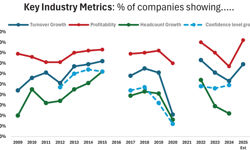A highly successful English businessman, famed for his negotiating skills, retires to an estate in rural Ireland. One night in the nearby bar he is approached by a local farmer offering to cut his large field and suggests one hundred euro. Eager to get out of the job himself, heavy negotiation ensues and the farmer is (surprisingly easily) beaten down to fifty euro. The next night, the farmer comes up to him, hands him a fifty note and thanks him for the high quality hay bought for winter feed at a bargain price. When it comes to a negotiation, it pays to know if you are buying or selling!
The Republic of Ireland can offer UK-based publishers significant sales opportunities but, unlike the Englishman of the true story above, it pays to understand this highly individualistic market in terms of culture, demographics and retail type. Think of Ireland purely as an export market or – even worse – an extension of the UK and you’ll soon become bogged down.
The Irish market represents 4.5 million highly-educated and articulate English speaking readers within less than an hour’s flying time of London. The €150 million magazine market is divided between UK published and indigenous titles, with UK imports accounting for around 80% of sales. In particular, there is a hungry appetite for womens’ and celebrity weeklies, partworks and teenage titles.
The economic expansion of the 1990s and very early years of this century – when Ireland became known as the Celtic Tiger – is well documented. Fuelled by foreign investments and immigration, the Irish economy grew at enviable rates and the country was financially and physically transformed. The magazine market tracked the tiger with average growth rates of 5% pa. Particularly impressive was the ability of local readers to dig deep into pockets. Allowing for currency conversion factors, distribution costs and a VAT rate of 13.5% - cover prices are relatively higher than in the UK. Some argue that the quarterly adjustments of prices to allow for the ups and downs of currency aids consumer insensitivity to price.
Ireland had a very tough recession. The tiger is more akin to a pussy-cat now. An economy over-dependant on construction and service industries hit the buffers overnight with unemployment in February 2009 reaching a high of 11%, a fact sadly only too noticeable when walking around daytime Dublin. The mix of UK and Irish titles makes it hard to fix exact market size – but one industry source estimates annual magazine sales in the Republic to be close to double digit declines, even allowing for healthy world cup and specials sales.
When comparing the market dynamics of the Republic of Ireland to the UK, there are two factors which are very different; the retail estate and the environmental climate. A third factor, a different wholesale template, is becoming increasingly aligned to the UK model.
Retailers
Firstly, retailers. Take a bus around Dublin city centre or – better still – drive out to country towns and the perceptive publisher will immediately notice the plethora of high quality convenience retailers, in particular Spar, Centra and the main petrol forecourt brands of Topaz and Esso. Estimates of the share of symbol groups and forecourts are 15% of the overall market. When you take into account that independent newsagents account for 35% plus of sales, you see a totally different picture to the UK where the convenience sector has seen slippage to the grocers. Des O’Dwyer, wholesale operations manager for News International is a fan. “Convenience retailing in the Republic trades at an incredibly high standard for both food and non-food”, he states.
“Stores are well stocked, with modern, full facing fixtures invariably offering a good range of newspapers and magazines from both sides of the Irish Sea. In the rural locations, this sector offers a large array of retail services and plays a vital role within local communities.” But supermarkets are making up ground. Tesco Ireland is estimated to have 10% plus of magazine sales and growing with a keen focus on a wide range and instore promotions.
For a true destination magazine store, it is hard to better Eason. The ground floor of the flagship O’Connell Street store is heaven for all lovers of the printed word. Nothing but newspapers, books and magazines of all shapes and sizes. If you have never been there, a must for next time. With a branch network of 52 and recent openings in Dublin and Cork airport terminals, this retail group now proffers share close to 10%.
Environmental concerns
So when planning your next circulation promotion in the Republic, take into account the different retail landscape and in particular the importance of symbol and convenience. But also be mindful of the softer issues, in particular the environmental backdrop. Ireland is not called the Emerald Isle for nothing; both politicians and people are fiercely proud of their beautiful landscape and determined that it stays that way. The publishing industry that serves the Republic – and UK publishers are very much part of that – face the same environmental issues as at home but in a more pronounced way. Ireland has no large-scale paper mill that is capable of recycling and scarce landfill is both fast running out and subject to EU taxation. Government is keenly sensitive to environmental issues – try and get a plastic carrier bag in an Irish store. Communication of the recycling message to consumers plus a move to full copy returns for all but the far-flung retailers has led to one of the highest recycling rates in Europe – 79%. Moreover, in the past, retailers have perceived the level of retail unsolds to be too high with distribution levels well out of kilter with sales expectations and have been vocal in expressing concern to Government.
To both clearly demonstrate its green commitment and to start to allay retailers’ concerns on box-outs, the whole industry, UK and Irish publishers, both newspaper and magazine, have come together with retailers and wholesalers to put into place a code of practice for distribution within the industry and a set of environmental standards. This has been a noticeable first for the business in the Republic and the rate of progress in creating standards and sharing best practice has been impressive. The UK’s Periodical Publishers Association (PPA) has played a key role in this. Director of circulation and membership, Nicola Rowe, states, “In the last two years, we have devoted a lot of time and resource to PPA members’ interests in the Republic. The Irish market can offer excellent circulation opportunities but there are a number of key environmental and retailer considerations that we have had to fully understand and address.”
Wholesale systems
The Irish wholesale system for magazines is becoming increasingly aligned to that in the UK but it started from a very different base. In times gone by, the majority of titles were available from both main magazine wholesalers, Eason News and Newspread. Retailers could, and did, buy and return unsolds from one, t’other or both. This may have given maximum possible retailer choice but was not ideal for accuracy of data or efficiency of distribution. In January 2008, Eason & Sons and Menzies Distribution joined forces to set up a new joint venture wholesale business – EM News Distribution. EMND’s head of business, Barry Harvey, points to the solid business foundations laid by the solus owners and stresses the significant investment levels in infrastructure and systems since the formation of the JV. He also singles out the move to full copy returns as a catalyst for improving wholesale processes.
Newspread are particularly proud of their retail service offer. Commercial manager Paul McDonnell points to modern warehousing, a greatly enhanced call centre, regular retailer roadshows, a dedicated field team and website functionally allowing retailers to manage their Newspread accounts online. Publisher and retailer processes are driven by recent investment in SAP technology
The wholesale market has also seen a fast move to exclusivity, with the majority of publishers supplying just one of the two competing firms.
Despite the convergence in wholesale systems, the Irish market is very different to the UK. The independent and convenience retail offering is more sophisticated with a focus on fresh produce and food-to-go. Most retailers will have two supplying magazine wholesalers plus a number of self-supplying newspaper publishers. Economic ups and downs are more pronounced. These factors have given birth to a unique and growing service company for retailers. According to founder Karen Meenan, the Daily Profit “takes the pain and hassle out of newsagency to increase net profit”. She claims that the news category is “loved by customers but loathed by the retailers themselves” as it is complex and labour intensive. For a weekly fee of €55, the Daily Profit offers training, weekly audits of wholesale and distributor paperwork and monthly store reports. Results are impressive – by focusing on lost credits and sell-outs, Karen claims she can add an annual €10,000 to a retailer bottom line. Publishers often make light of the complexity of their category and the Daily Profit is a good example of a business which is not frightened to delve into detail. It has the potential to prosper in good times and bad.
The Irish market has been good to those publishers who have understood it, invested in it and turned the occasional blind eye to its eccentricities. Times are tough at the moment but research for this article and regular trips to Dublin and beyond always impress with a positive belief that good times will return. Next time you have a distributor review, put the Republic as an agenda item and ask your distributor perceptive questions. Be ready for the upswing.










